 Wines have been made in the land that is present day Israel for thousands of years, yet, the Israeli wine industry is really just at its beginnings. Like so much about Israel, the dichotomies between young and old, history and present day, and the political realities of a young country manifest in its wines.
Wines have been made in the land that is present day Israel for thousands of years, yet, the Israeli wine industry is really just at its beginnings. Like so much about Israel, the dichotomies between young and old, history and present day, and the political realities of a young country manifest in its wines.
There are many references to wine and winemaking found in the Old Testament. In ancient times, Israel was on the trade routes of Egypt and Mesopotamia and wine was almost certainly one of the commodities traded. Ruins of ancient wine presses over 2,000 years old can still be visited in Israel. Israeli wine was prized in ancient Rome often above the locally produced wines. Of course, Jesus turned water into wine at the Wedding in Cana in the Galilee (does that count?). With the Islamic conquest of the area in the seventh century, the wine industry ended. The existing grape vines were ripped out. Sadly, no one knows today what types of grapes were indigenous to the area or brought there by early traders and what types of wines were made.
The modern era of Israeli wine making dates to end of the 19th century, when Baron Edmond Rothschild of Chateau Lafite Rothschild in Bordeaux, helped to establish the Carmel Winery near Haifa. The Baron imported mainly Bordeaux varietals for this venture. The wines produced were sweet kosher wines. This sweet style of wine became synonymous with kosher wines. In the 1960s Carmel released what is believed to be Israel’s first dry commercial wine. Finally, in the late 1980s smaller, boutique wineries entered the scene. The growth continued during the 1990s and to this day. There were 70 wineries in 2000 and that number doubled over the next five years. Today, there are 35 large scale wineries and approximately 250 boutique wineries. Israel produces 36 million bottles of wine annually.
The five largest wineries account for 75% of all wine production. They are Carmel, Barkan Wine Cellars, Golan Heights, Teperberg 1870, and Binyamina Wine Cellar. In addition, Galil Mountain, Tishbi, Tabor, Recanati and Dalton make a significant amount of wine as well. The three largest producers, Carmel, Barkan Wine Cellars and the Golan Heights Winery, dominate production. Domestically, these three account for 80% of Israel’s growing wine appetite. Israelis drink about 4.6 liters of wine per person annually. Israel also exports around $30 million dollars in wine. The top export market is the United States.
Most of the wine is made from Cabernet Sauvignon, Merlot, Chardonnay, and Sauvignon Blanc. The rise of boutique wineries has seen some successful experimentation with Cabernet Franc, Gewurztraminer, Muscat, Riesling and especially Syrah.
Israel has a hot Mediterranean climate. Summer is very hot and runs from April thru October. There is almost no rain. The months of October thru March see about twenty inches of rain. Israel is a small country, about the size of New Jersey, yet there are five different winegrowing regions. In the north, the Galil, which encompasses the Golan Heights, and upper and lower Galilee areas, The Judean Hills (in the area surrounding Jerusalem), the Shimshon (Samson) (between the Judean Hills and the Mediterranean), the Negev (the desert area in the South), and the Shomron which includes the Sharon Plain just south of Haifa near the Mediterranean. Most of the plantings are in the Galil, Shomron, Shimshon. Drip irrigation is essential in all growing areas.
The Galil is the most classic of all growing areas. The area extends from the Lebanese border in the north, to the Syrian border in the northeast, and covers most of northern Israel. It includes areas of the Golan Heights which were captured by Israel in the 1967 war. Some of the vineyards here reach 4,000 feet in altitude. The higher elevations experience hot days followed with cooler evenings (snow falls here during the winter). Due to the heat, harvest is often done at night or very early in the morning. Approximately 1,600 acres are under vine. The most famous winery is the Golan Heights winery, which produces wine under the Yarden, Gamla and Golan labels. The Dalton winery is in the Galil Mountains. The soils here often are volcanic due to extinct volcanoes. Much of this area is the northern end of the Great African Rift Valley.
The Shomron includes the Carmel Mountains and is the largest wine growing region in Israel. The soils have a limestone base to them. The summers are hot and the winters can be rainy. This is the home of some of Israel’s largest wineries including Carmel, Tishbi and Binyamina.
The Shimshon (Samson) is the central coast plain down to the Judean lowlands. It is named after the biblical Samson. The soils are limestone and clay and the climate is more influenced by the Mediterranean: hot, humid summers and pleasant winters. Carmel Winery is located here as well as Barkan and Segal.
Exciting things are going on the Judean Hills. The soil here is thin and rocky. The days are hot, evenings are cool and rainfall is slight. Many of the more interesting boutique wineries are found here, less than an hour’s drive from Jerusalem.
Finally, the Negev is the arid, desert region which makes up much of southern Israel. Even in the hill area of the north, the vineyards must rely on irrigation. This is very hot during the day, but due to the altitude, about 600 meters, there is some relief at night. The soils here are mostly sandy with some loam. Many of the larger wineries are producing wine here with some interesting success.
Getting the world to understand and taste Israeli wine is a problem. Perhaps the leading advocate and critic was Daniel Rogov who sadly passed away in 2011. Mark Squires, who reviews wines for Robert Parker’s Wine Advocate, was recently assigned coverage of the area, so there is some exposure. Israeli wines are, for the most, part priced fairly for the quality of wine in the bottle. There are some retailers, however, who take advantage of those restricted to drinking kosher wines and raised those prices.
The vast majority of Israeli wines are kosher. Kosher is a set of dietary laws followed by many Jews. There are two ways to produce a kosher wine. If a wine is handled only by observant Jews at every stage from the vineyard to bottling, it is considered Kosher. Of course the production process strictly prohibits contact with any non-kosher ingredients including fining agents such as gelatin or non-kosher cultured yeasts. I had always been under the impression that this requirement of being handled by an observant Jew started at harvest, but at a recent visit to a winery in Israel, we were not allowed to visit the vineyard without a Mashgiach (observant Jew) to accompany us.
Traditionally, this method was not always possible, so the Mevushal process is available. This requires the wine to be heated (traditionally referred to as boiled) to around 175F before bottling. Between being heated and bottled, it may be handled only by an observant Jew. The traditional Mevushal procedure does hinder the quality of the wine. Today, a flash pasteurization method is used that has eliminated some of the stewed fruit qualities often associated with Mevushal wines. Still, in an effort to make better wines, it seems there is a trend to bring in observant Jews into the winery to produce kosher wines without the Mevushal process.
Many wines made in Israel are not kosher limiting the potential market, both locally and for export. Therefore, all the larger producers are kosher and it appears many of the boutique wineries are obtaining kosher certification as well. There is one other difference in kosher wines. No work is permitted on the Sabbath even during the fermentation stage. Wine, normally being punched down every few hours or so, is left alone during that twenty-four hour period. Is this enough to make a difference? I believe so, but not enough to drastically limit quality.
Due to the hot climate, Israeli wines tend to have slightly lower acidity. This raises a question as to how well they will age. I was recently treated to a 2002 Margalit Cabernet Sauvignon Single Vineyard Kadita. This was the most aged Israeli wine I have ever had. At ten years old, it was still drinking beautifully. Ruby in color there is some browning at the edges. The nose is very nice with cigar tobacco, cassis, dried cranberries and some bell pepper. On the palate, medium bodied with some cassis fruit left. A delightful, mature Cab and a real treat to try. Here are some other recommended wines:
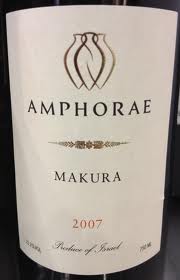 The 2007 Amphorae Makura was easily the best Israeli wine I have ever had. Amphorae was started in 2000 and sold in 2008. The new owners, the Dubov family, retained Michel Rolland, one of the world’s leading wine consultants. This wine is a blend of Syrah, Cabernet and Merlot. The nose is huge with leather, black raspberries, dark cherries, cassis, smoke and dust. On the palate, this is ripe and a touch sweet, most likely due to high alcohol levels, but delicious and no feel of alcohol. Complex and very young, it took some time to unwind, showing layers of fruit and development. Full bodied with a lush texture, just a beautiful wine.
The 2007 Amphorae Makura was easily the best Israeli wine I have ever had. Amphorae was started in 2000 and sold in 2008. The new owners, the Dubov family, retained Michel Rolland, one of the world’s leading wine consultants. This wine is a blend of Syrah, Cabernet and Merlot. The nose is huge with leather, black raspberries, dark cherries, cassis, smoke and dust. On the palate, this is ripe and a touch sweet, most likely due to high alcohol levels, but delicious and no feel of alcohol. Complex and very young, it took some time to unwind, showing layers of fruit and development. Full bodied with a lush texture, just a beautiful wine.
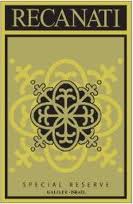 2008 Recanati Special Reserve Kosher. Recanati is one of the larger wineries in Israel. It’s winemaker is Gil Shatsberg, one of the founders of Amphorae, and a graduate of the UC Davis wine program. This wine was really interesting. I was told it was a Bordeaux blend, but it tastes like there is some Syrah as well. Ruby/purple in color. The nose has black raspberries, black cherries, grilled meats, and tobacco. It took a while to unwind at the table, but then really showed some nice layering. Lots of upfront fruit but it seems like down the road, it’s going to be the Rhone varietals that give it some development. Nice acidity that worked well with food.
2008 Recanati Special Reserve Kosher. Recanati is one of the larger wineries in Israel. It’s winemaker is Gil Shatsberg, one of the founders of Amphorae, and a graduate of the UC Davis wine program. This wine was really interesting. I was told it was a Bordeaux blend, but it tastes like there is some Syrah as well. Ruby/purple in color. The nose has black raspberries, black cherries, grilled meats, and tobacco. It took a while to unwind at the table, but then really showed some nice layering. Lots of upfront fruit but it seems like down the road, it’s going to be the Rhone varietals that give it some development. Nice acidity that worked well with food.
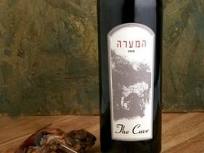 2008 The Cave (Hamearah) Cabernet-Merlot. Part of the large Binyamina winery, this is another wine that exceeded my expectations. I believe this is a Bordeaux blend. Ruby/purple in color. The nose is big with cassis, black cherries, some tobacco and anise. Tannic and very big on the palate. Lots of black cherry fruit. With air, this develops nicely and shows some complexities. Long finish. This was the biggest of all the wines I tried in Israel.
2008 The Cave (Hamearah) Cabernet-Merlot. Part of the large Binyamina winery, this is another wine that exceeded my expectations. I believe this is a Bordeaux blend. Ruby/purple in color. The nose is big with cassis, black cherries, some tobacco and anise. Tannic and very big on the palate. Lots of black cherry fruit. With air, this develops nicely and shows some complexities. Long finish. This was the biggest of all the wines I tried in Israel.
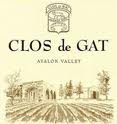 2007 Clos de Gat Ayalon Valley. Clos de Gat is a picturesque boutique winery in the Judean Hills. They are partnered up with a Kibbutz which gives them the ability to control growing their grapes without the excessive tax ramifications that can stifle small grower-winemakers. While I found their wines to be hit and miss, this one was a hit. The nose is Bordeaux-like with cassis, cherries, and warm dusty attic notes. On the palate, this is mature and I doubt gets better. Nice layering of cassis and cherries with some earthiness and dried leather notes. Good acidity and balance. Nice finish. Very food friendly and certainly a wine that we all enjoyed drinking very much.
2007 Clos de Gat Ayalon Valley. Clos de Gat is a picturesque boutique winery in the Judean Hills. They are partnered up with a Kibbutz which gives them the ability to control growing their grapes without the excessive tax ramifications that can stifle small grower-winemakers. While I found their wines to be hit and miss, this one was a hit. The nose is Bordeaux-like with cassis, cherries, and warm dusty attic notes. On the palate, this is mature and I doubt gets better. Nice layering of cassis and cherries with some earthiness and dried leather notes. Good acidity and balance. Nice finish. Very food friendly and certainly a wine that we all enjoyed drinking very much.
 2010 Flam Syrah Reserve. Started in 1n 1998 by two brothers, Golan and Gilad Flam, whose father Israel was the winemaker for the giant Carmel winery. I was lucky enough to be toured around by Israel, and his pride was evident. Flam makes some nice value priced wines, but its line of Reserve wines is excellent. This Syrah is made from Upper Galilee fruit. It is purple/blue in color and mostly clear and bright. The nose has black raspberries with some floral qualities. Medium to full bodied. Medium tannins. Nice acidity. Good black raspberry fruit. Drinks like a mid range Cote Rotie although still quite young. The Cabernet Reserve was also quite good.
2010 Flam Syrah Reserve. Started in 1n 1998 by two brothers, Golan and Gilad Flam, whose father Israel was the winemaker for the giant Carmel winery. I was lucky enough to be toured around by Israel, and his pride was evident. Flam makes some nice value priced wines, but its line of Reserve wines is excellent. This Syrah is made from Upper Galilee fruit. It is purple/blue in color and mostly clear and bright. The nose has black raspberries with some floral qualities. Medium to full bodied. Medium tannins. Nice acidity. Good black raspberry fruit. Drinks like a mid range Cote Rotie although still quite young. The Cabernet Reserve was also quite good.
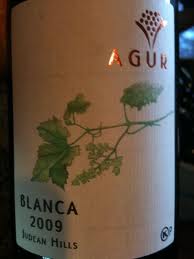 2010 Agur Blanca Kosher. Every region has its eccentric older winemaker and Shuki, the owner-winemaker here fits that bill. A visit can be challenging, but hold your own and taste thru the wines. While I really enjoyed the Special Reserve Red, it was this white that interested me, being a blend of Riesling and Viognier. Light golden in color. The nose has mostly grapefruit with a slight apricot note. The Viognier is harvested at three separate times and the late harvest supposedly accounts for the apricot note. It is bone dry with a touch of bitterness. It has a slightly viscous texture that is pleasing and refreshing. Nice grapefruit notes. Good acidity. Long finish.
2010 Agur Blanca Kosher. Every region has its eccentric older winemaker and Shuki, the owner-winemaker here fits that bill. A visit can be challenging, but hold your own and taste thru the wines. While I really enjoyed the Special Reserve Red, it was this white that interested me, being a blend of Riesling and Viognier. Light golden in color. The nose has mostly grapefruit with a slight apricot note. The Viognier is harvested at three separate times and the late harvest supposedly accounts for the apricot note. It is bone dry with a touch of bitterness. It has a slightly viscous texture that is pleasing and refreshing. Nice grapefruit notes. Good acidity. Long finish.
There are many other wineries making good wine. Included would be Yatir Forest, Zauberman, Lewinsohn, Segals, Ben Zimra, Tishbi and Dalton and many I have not had the pleasure of trying. I have Israeli wines in my cellar and plan to continue to try them. The future is very bright. I would love to hear which ones you liked.





